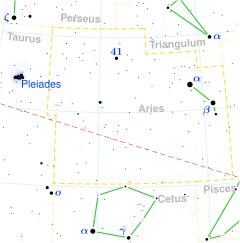Theta Arietis
Theta Arietis, Latinized from θ Arietis, is the Bayer designation for a star in the northern constellation of Aries. It is faintly visible to the naked eye with an apparent visual magnitude of 5.58.[2] With an annual parallax shift of 7.29 mas,[1] the distance to this star is an estimated 450 light-years (140 parsecs) with a 20 light-year margin of error.
 | |
| Observation data Epoch J2000 Equinox J2000 | |
|---|---|
| Constellation | Aries |
| Right ascension | 02h 18m 07.53838s[1] |
| Declination | +19° 54′ 04.1862″[1] |
| Apparent magnitude (V) | 5.58[2] |
| Characteristics | |
| Spectral type | A1 Vn[3] |
| U−B color index | +0.02[4] |
| B−V color index | +0.01[4] |
| Astrometry | |
| Radial velocity (Rv) | +6.0[2] km/s |
| Proper motion (μ) | RA: –13.19[1] mas/yr Dec.: +0.72[1] mas/yr |
| Parallax (π) | 7.29 ± 0.29[1] mas |
| Distance | 450 ± 20 ly (137 ± 5 pc) |
| Absolute magnitude (MV) | −0.10[5] |
| Details | |
| Radius | 1.9–2.5[6] R☉ |
| Luminosity | 106[5] L☉ |
| Rotational velocity (v sin i) | 186[7] km/s |
| Other designations | |
| Database references | |
| SIMBAD | data |
This is a white-hued, A-type main sequence star with a stellar classification of A1 Vn.[3] It is spinning at a rapid pace as shown by the projected rotational velocity of 186 km/s.[7] This is causing the "nebulous" appearance of the absorption lines indicated by the 'n' suffix in the classification.
References
- van Leeuwen, F. (November 2007), "Validation of the new Hipparcos reduction", Astronomy and Astrophysics, 474 (2): 653–664, arXiv:0708.1752, Bibcode:2007A&A...474..653V, doi:10.1051/0004-6361:20078357.
- Wielen, R.; et al. (1999), Sixth Catalogue of Fundamental Stars (FK6). Part I. Basic fundamental stars with direct solutions, Astronomisches Rechen-Institut Heidelberg, Bibcode:1999VeARI..35....1W.
- Cowley, A.; et al. (April 1969), "A study of the bright A stars. I. A catalogue of spectral classifications", Astronomical Journal, 74: 375–406, Bibcode:1969AJ.....74..375C, doi:10.1086/110819.
- Rybka, E. (1969), "The corrected magnitudes and colours of 278 stars near S.A. 1-139 in the UBV system", Acta Astronomica, 19: 229, Bibcode:1969AcA....19..229R.
- Anderson, E.; Francis, Ch. (2012), "XHIP: An extended hipparcos compilation", Astronomy Letters, 38 (5): 331, arXiv:1108.4971, Bibcode:2012AstL...38..331A, doi:10.1134/S1063773712050015.
- Pasinetti Fracassini, L. E.; et al. (February 2001), "Catalogue of Apparent Diameters and Absolute Radii of Stars (CADARS) - Third edition - Comments and statistics", Astronomy and Astrophysics, 367: 521–524, arXiv:astro-ph/0012289, Bibcode:2001A&A...367..521P, doi:10.1051/0004-6361:20000451.
- Royer, F.; Zorec, J.; Gómez, A. E. (February 2007), "Rotational velocities of A-type stars. III. Velocity distributions", Astronomy and Astrophysics, 463 (2): 671–682, arXiv:astro-ph/0610785, Bibcode:2007A&A...463..671R, doi:10.1051/0004-6361:20065224.
- "* tet Ari". SIMBAD. Centre de données astronomiques de Strasbourg. Retrieved 2012-08-06.
This article is issued from Wikipedia. The text is licensed under Creative Commons - Attribution - Sharealike. Additional terms may apply for the media files.